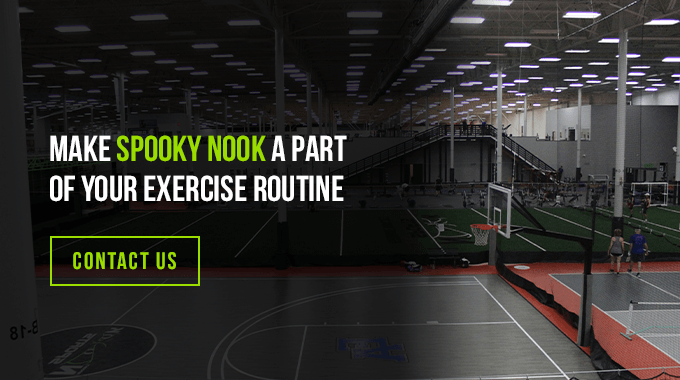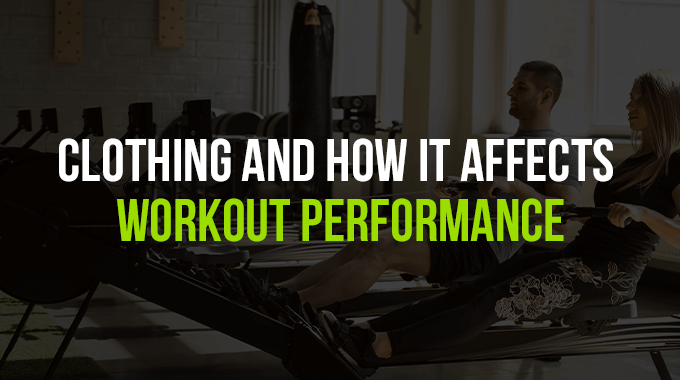
Subscribe to the Blog
Stay up to date
In recent years, athletic wear has become a massive industry created by high-end brands and box stores alike. While its rise in popularity has led many people to buy their first piece of activewear, it's more of a movement in fashion than anything else. The concept of athleisure is now many people's idea of being comfortable yet stylish.
Even though athletic wear can be fashionable, it started as clothing designed for performance. Many developments in athletic wear have made leggings, shorts, tops and jackets more functional than ever. Even if consumers love to wear active clothing as streetwear, there's no denying how their many features make these clothing items excellent for your workout.
One of the defining features of athletic clothing is the material. These fabrics are made of synthetic materials that offer more flexibility and responsiveness to your body than natural fibers. Traits like fast-drying abilities contribute to your workout in several ways. Additionally, workout clothing can take many forms. It can include leggings, shorts, tank tops, jackets and long sleeve shirts. These pieces all offer the same performance fabrics that help you give the most to your workout.

Altogether, athletic clothing helps prevent injuries, improve breathability, protect you from the elements and fuel your fitness mentality. Explore the science behind the importance of a good gym outfit to learn more about your workout gear. This way, you can learn how to choose the right workout clothes.
1. Injury Prevention
The proper clothing can ensure you don't injure yourself during a workout. Specifically, compression gear ensures your blood flow stays normal and you don't experience too much lactic acid buildup. Keep reading to learn more:
Low Blood Flow
A typical feature of workout clothing is compression qualities, which exist for one reason — circulation. These types of clothing apply slight pressure to veins, facilitating more blood flow and keeping your heart pumping. This phenomenon is the same reason people use compression socks when they have poor circulation or work on their feet all day.
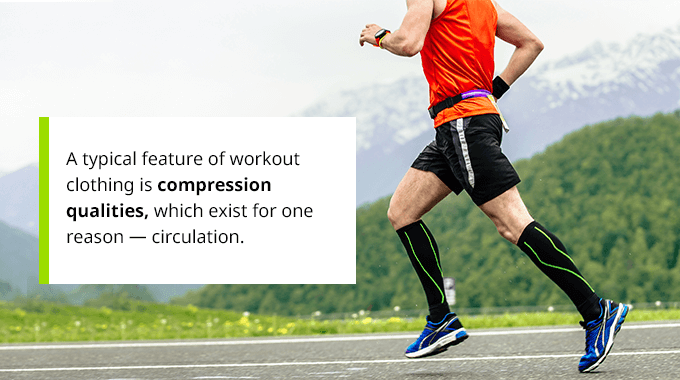
As blood flow increases, your heart pumps more oxygen to your muscles. When you're working out, oxygenation is critical for maintaining energy levels and reducing fatigue. Generally, low oxygenation during a workout leads to fatigue as you're moving. If you're exhausted, you're more likely to give up on your form.
Practices like keeping your core tight, holding a wide stance, and maintaining your posture are essential for working your muscles effectively and protecting your spine. If your form loosens, you're more likely to experience back injuries and pulled muscles. While the improper form can result from inexperience, even the most seasoned fitness guru can fall victim to extreme fatigue.
In cold weather, blood flow is even more critical. If you decide to go for a run in the winter during cold temperatures, the body tries to conserve heat, so blood flow decreases in the limbs. Because the arteries shrink, it's harder for the heart to pump blood throughout the body. Also, cold weather causes your muscles and joints to contract. This tightness limits range of motion and increases the chance of pinched nerves and pulled muscles.
Lactic Acid Buildup
Low oxygen levels can also lead to the development of lactic acid. While lactic acid isn't necessarily bad, it can contribute to fatigue and stiffness, especially the day after a high-intensity workout. This substance makes your muscles stiff and sore, demanding a recovery period.
What is lactic acid? It's a by-product of glycolysis. Typically, your body uses oxygen to create adenosine triphosphate (ATP), a primary energy source. When oxygen levels are low, the body looks to another process to create ATP called the glycolytic system. This system leads to glycolysis, which produces pyruvate that builds up into lactate and converts to lactic acid in the muscle cell.
That burning sensation you feel in your muscles during anaerobic exercise is a sign that lactic acid is building. This burn may even cause you to lose your form. With compression clothing, you can improve oxygen levels to reduce lactic acid buildup in every workout. Keep in mind you may still experience lactic acid in high-intensity interval training when you're trying to improve your endurance.
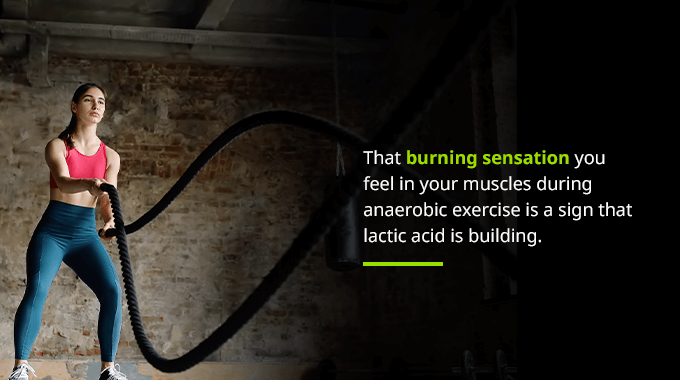
How Workout Gear Helps
Adding compression gear can make blood flow a little easier for your body. If you like to exercise outside in the winter, you should especially make sure you come prepared with compression clothing. Maintaining proper blood flow is one of the tops reasons why you should wear workout clothes.
When it's time to pick out compression wear, be sure to do some research. Check that your leggings or tights are the right size, as too much compression can be uncomfortable. Shop around to find suitable clothing for a safe workout.
2. Sweat-Wicking and Breathability
Regardless of the types of exercise you enjoy, you probably sweat while doing them. This process is a natural way for your body to cool itself down, but it can lead to overheating, too. The best clothes for the gym will have moisture-wicking characteristics to facilitate your body's cooling process.
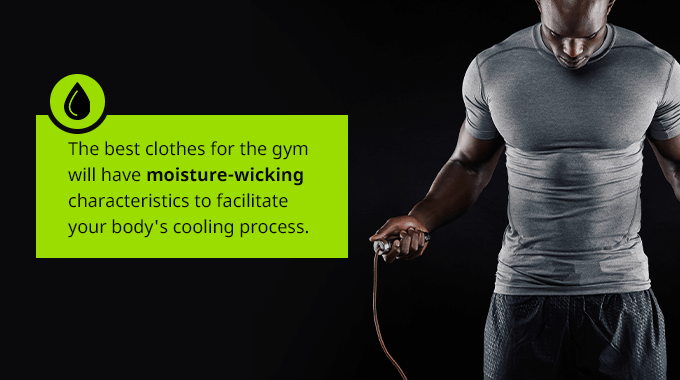
Increased Heart Rate
While cold temperatures can have harmful effects on your body as you workout, excess heat can also be damaging. As a way to cool yourself, your body circulates more blood through your skin, taking blood flow away from the muscles. A reduced blood flow in your muscles leads to an increased heart rate. These conditions can lead to heat-related illnesses.
An increased heart rate caused by heat can lead to cramping and lightheadedness. These experiences can be minor, but they can still affect your focus during your workout and lead you to put less effort into your exercise. When you're looking to push yourself physically and build muscle, a lack of focus can decrease the value of your workouts.
Overheating
Remembering to wear clothing with sweat-wicking fabric can help your body's moisture management. Though sweat is an essential aspect of your body's heat response, many factors can limit its effectiveness. In an ideal environment, your body will sweat as it warms up, and the evaporation will cool your skin. This physics principle is called the heat of vaporization.
This evaporation can't always occur when necessary. The air's humidity determines how easily your sweat will evaporate. If you're working out in a humid environment, your sweat will stick around on your skin. This excess sweat might make you feel sticky and uncomfortable during a workout, but it also contributes to overheating.
To cool your skin down, evaporation must happen. If sweat stays on your skin and you continue to heat up, your body temperature will increase faster than usual. These temperature spikes are more likely to lead to muscle cramps and dizziness. In severe cases, heat illnesses can require medical treatment.
How Workout Gear Helps
In environments where you're sweating excessively and evaporation can't do its job, sweat-wicking fabrics can save the day. Specifically, performance-tested workout clothing will use a moisture management tester (MMT) to determine how well the fibers will respond to sweat. These fabrics need to have high wicking speed, decent attraction to water, and a fast drying time to create a comfortable microclimate for your body.
When you sweat in moisture-wicking workout clothes, your sweat quickly travels through the fabric to the outside of the fibers. The removal of sweat from your skin prevents the heat buildup that comes with a lack of evaporation. Plus, the fibers will dry quickly to prevent a new layer of moisture created by your clothing.
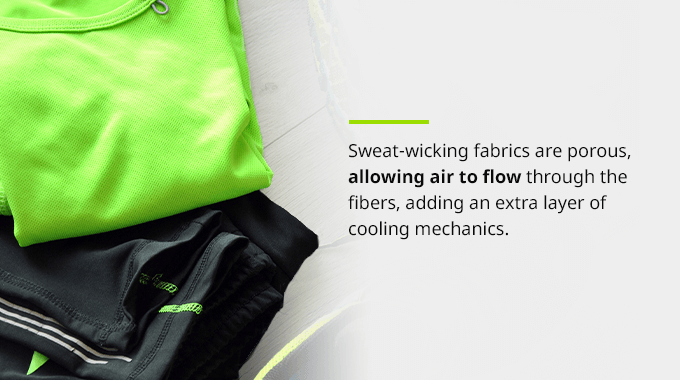
These sweat-wicking fabrics are porous, allowing air to flow through the fibers, adding an extra layer of cooling mechanics. Ultimately, the best gym and workout clothes will improve your overall feeling as you're exercising. Keeping your body cool makes it easier for your body to work hard, so you can put forth your best effort.
While moisture-wicking fabrics are most valuable for hot temperatures, they can also be helpful for cold temperatures. Vented outer layers provide breathability when you're exercising outdoors in the winter. Rather than overheating in your warm layers, you can keep your muscles loose without disrupting your body's temperature regulation.
3. Environmental Protection
Though exercising outside can be an excellent way to get out of the house and enjoy the fresh air, it does come with some uncontrollable factors. Elements like sun and rain can stand in your way when you're trying to get a good workout in for the day. As a result, your choice of workout clothes can protect your body from the environment as you get your blood pumping.
To some degree, the sun is good for us. With its source of vitamin D, the sun helps your body regulate calcium to keep your teeth, bones, and muscles healthy. Though it's valuable to spend time outside, it's possible to be exposed to too much sun. The sun emits rays with ultraviolet (UV) radiation, which is the reason your skin can soak up vitamin D. However, overexposure can lead to sunburn or more pressing health matters.
Sunburn
Almost always, too much sun exposure leads to sunburn. If you have light skin, hair and eyes, you may have experienced sunburn more than those with higher melanin production. If you're spending time exercising in direct sunlight, you increase your risk of getting burnt.
While sunburn can lead to a hot and achy feeling on the surface of your skin, sunburn over a long period of time leads to more significant results. Excess UV rays can accelerate skin aging, leading to wrinkles earlier in life. Even frequent tanning can increase your risk of developing skin cancer, the most common cancer in the United States.
How Workout Gear Helps
Often, athletic wear includes a higher ultraviolet protection factor (UPF) than standard fabrics. The UPF of a cotton T-shirt may be about five, whereas clothing specifically made for sun protection can have a 50 UPF. Alongside sunscreen, it's crucial to wear workout gear with a high UPF to protect yourself.
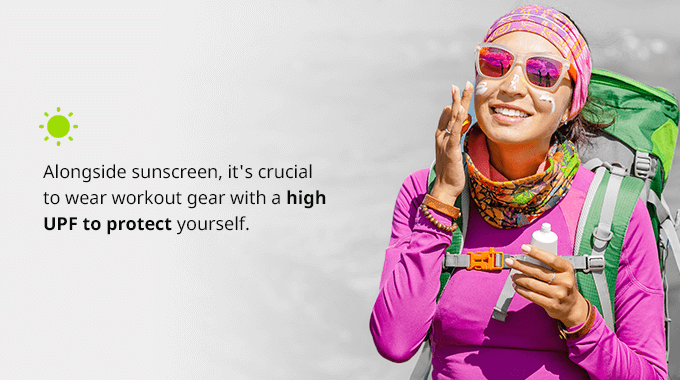
Attire with a high UPF uses a specialized fabric that protects your skin from the sun. It also has a tighter weave to limit gaps. The high thread count makes UPF fabrics feel soft and luxurious, which is an added bonus to your sun protection.
While you'll often encounter sun during your outdoor workouts, you might experience rain, too. These athletic fabrics come with moisture-wicking and deflecting properties to help with your sweat, and they can prevent your clothes from absorbing water from rain. This way, you won't be weighed down by water, and you can work your hardest.
4. Better Mentality
There are several characteristics of athletic wear that improve the physical workout experience, but the importance of a good gym outfit can extend to your mentality. While you understand how workout gear affects performance, it can also be a cue to keep up with your exercise habits. The best workout gear is what makes you feel motivated and confident.
Sticking With Habits
A habit is a routine behavior that you follow through with subconsciously, and you can use your own psychology to your advantage. Forming a habit starts with a series of steps. These actions formulate the routine in your brain, making it easier over a period of time to enact the routine.
First, you have a trigger or cue that lets your brain know it's time to start a behavior. From there, you enact the routine. This behavior could be flossing, taking your vitamins or another daily occurrence, but it's what we'd consider a habit. After the action, the final step is a reward that your brain likes, so it remembers to respond to the habit in the future.
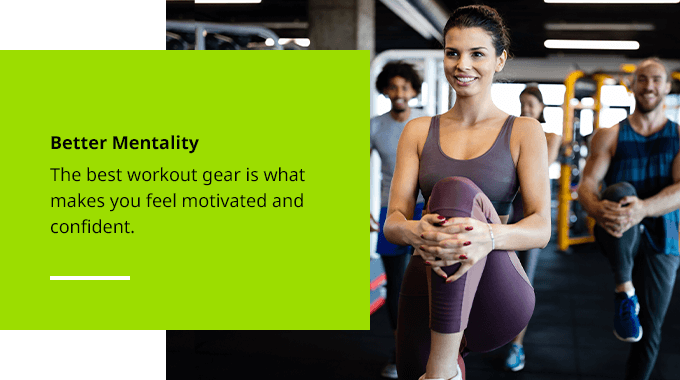
If you're trying to drink a glass of water in the morning, your trigger might be entering the kitchen when you first wake up. The habit is drinking the water, and the hydration afterward acts as a reward. When you want to build an exercise habit, your athletic wear can act as your habit cue, and the endorphins after your workout will act as the reward.
When you want to start a workout habit, your brain doesn't have the instructions to follow through yet. Research in habit-forming in the brain reveals a pattern in the striatum, a part of the basal ganglia. When a habit first begins, the neurons in the striatum will fire continuously to retain the habit. As the behavior becomes habitual, the neurons only fire in clusters at the beginning and end.
These neuron patterns are what makes habits hard to break. It can be challenging to break the loop when it's unhealthy behavior. If it's a healthy behavior, it's easy to keep it up once it starts.
How Workout Gear Helps
If you're looking to build a workout habit, your workout clothes are an excellent way to get started. When you start creating your habit, get into your workout clothes right before you want to exercise. This could be first thing in the morning or right after you get home from work. Once you put your clothes on, it's important to follow through with your workout, so your neurons can create their pattern.
This habit-forming trick is a valuable tool to anyone, but it's essential to treat your workout clothes as exclusive to your workout habit. While athleisure has become popular in recent years, wearing your workout gear for style during the day can disrupt the meaning of the habit in your brain. Keep your athletic gear exclusive to exercise so your habit trigger will form with time.
After you've created your habit, putting on your gym clothes will be an immediate signal to your brain — you may be surprised how ready you are to work out once your sweat-wicking fabrics are on. While the endorphins for your exercise will act as a natural reward for your routine, you can also treat yourself to some new gear every now and then to feed your healthy habit mentality.
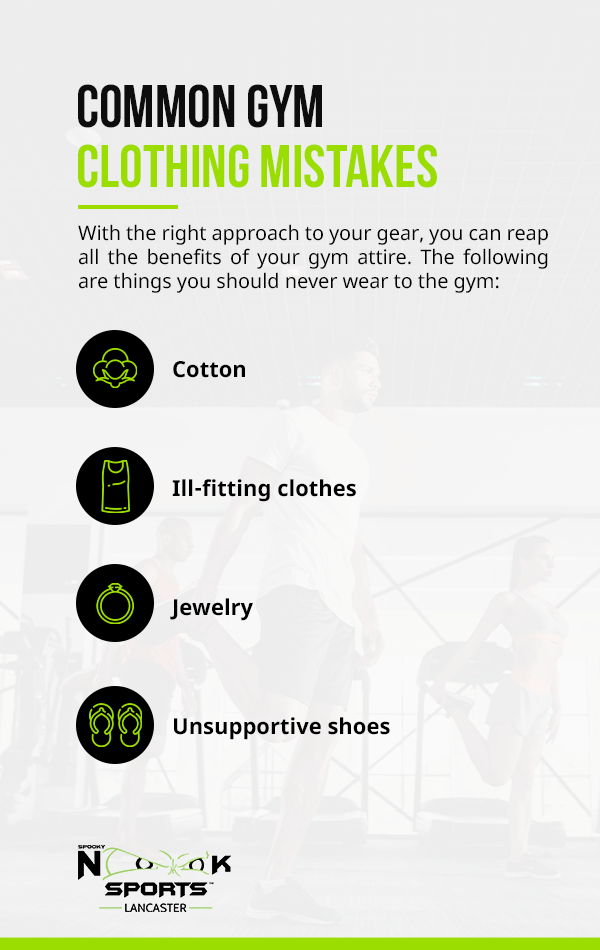
Common Gym Clothing Mistakes
With an understanding of just how functional athletic wear is, you can keep your eye out for some common gym clothing mistakes. With the right approach to your gear, you can reap all the benefits of your gym attire. The following are things you should never wear to the gym:
- Cotton: Remember, moisture-wicking fabrics are your best friend when you're sweating, and cotton is quite the opposite. As a natural fiber, it absorbs water, but it doesn't dry or wick like specialty fabrics. While it may feel breathable, eventually it'll be too moist for comfort, and it may even smell.
- Ill-fitting clothes: The flexibility of athletic fabrics supports a full range of motion while you're working out. This may not apply if your clothes don't fit. While clothing that's too small can restrict your motion, articles that are too big can limit sweat-wicking abilities.
- Jewelry: While jewelry is never designated as athletic wear, it might be a part of your outfit before you head to the gym. If you're wearing rings, necklaces and other jewelry, you run the risk of catching them on machines and getting hurt. If you use a fitness watch of some kind, make sure it has a soft silicon band rather than metal, so you can use weight machines without putting yourself at risk. Avoiding injury is the top reason why you should wear proper attire in the gym.
- Unsupportive shoes: Shoes are just as important to the quality of your workout as your clothing. Whether you're running or weight lifting, your feet work hard during exercise, so it's important to protect them from shock and ensure they're stable. Shoes like flip-flops and sandals are a definite safety risk because your toes are exposed. Shoes with thin canvas won't provide the ankle or arch support you need.
Knowing the common mistakes regarding workout gear can help you create the ideal ensemble every time you head to the gym.
Use Basic Workout Clothes to Optimize Your Workout
Do workout clothes make a difference? The answer is a resounding yes. Whether you're working out in a gym or going outside to work through your routine, athletic wear can transform your performance. It can reduce your risk of injury, regulate your body temperature, protect you from the elements and trigger a habit with your workout clothing.
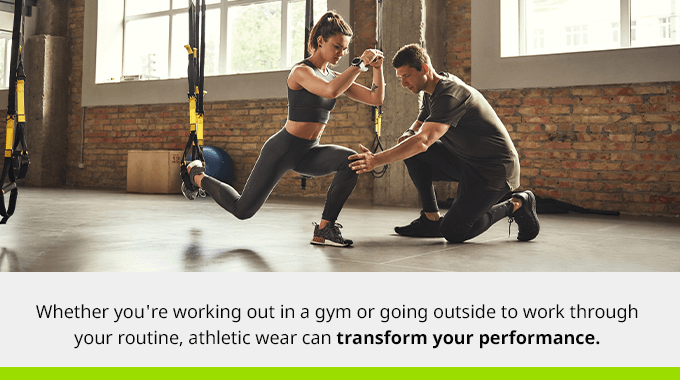
With all the options available for workout gear, there's something for everyone. Since workout gear has become stylish, many companies are creating pieces with patterns and colors that suit your personality, too. The drive toward fashion in gym clothes has pushed many brands to add design elements that are as aesthetically pleasing as they are functional, like mesh pockets and convertible tops.
The available styles make it easy to find something you feel confident and secure in, so you can tackle your workouts with enthusiasm every time. Look into the materials and compression signifiers to ensure you're getting high-quality clothing that can improve your performance. Since your athletic wear can make it easier to work harder, the investment is worth it in the long run.
Make Spooky Nook a Part of Your Exercise Routine
At Spooky Nook, we have a range of sports games, fitness groups and personal training to create an ideal environment for your exercising goals. Explore our full range of fitness training to find your ideal opportunities. Remember to wear your athletic wear to get the most from your workout at our facilities — what you wear in the gym matters!
If you'd like to learn more about our space, you can get in touch with us online.











